

iPhone 16 (Plus) review – what’s really new?
Apple usually saves any big innovations for its Pro models. But this year, the regular iPhone version’s been given a few new features, too. So is it worth upgrading from the previous model to the new one? Not in every case.
Wow, a new button! Great! Amazing! LIFE CHANGING! The sarcastic comments are plenty. People are missing real innovation. So much so, in fact, that fellow editor Samuel put this premise to the test and researched whether Apple’s phones really feature less and less innovation.
In this review, I’m comparing the basic model with the predecessor iPhone 15. I want to find out if it’s worth getting the upgrade. I’m using the Plus version, which hardly differs from its smaller sibling apart from the size and battery.
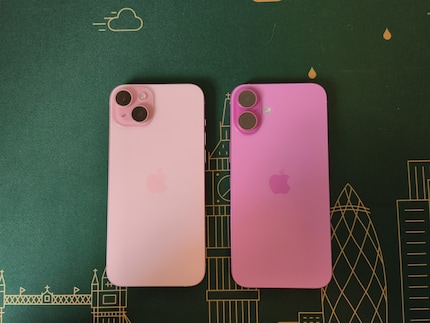
Source: Florian Bodoky
Apple’s AI, Apple Intelligence, hasn’t arrived yet. The first features will be available in October – in English. By the time the full range of functions’s been rolled out and is available in German, we’ll be getting our spring clothes out.
The exterior: more changes than with the Pro, but nothing fundamental
First things first: unlike the Pro models, the size of the devices remains unchanged. iPhone 16 measures 6.1 inches; iPhone 16 Plus 6.7 inches. I like it. That’s all I need.
Despite the size, iPhone and iPhone Plus only weigh 199 grammes. That’s two grammes less than the predecessor and the same as the Google Pixel 9 Pro, which is 0.4 inches smaller.
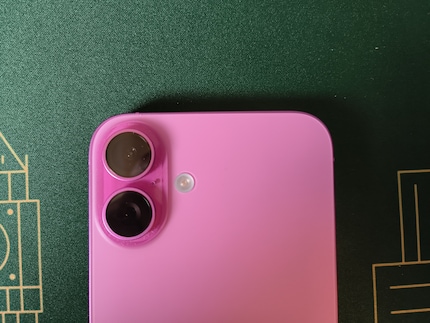
Source: Florian Bodoky
The camera array on the back has changed. After three iPhone generations with diagonally arranged camera lenses, they’re now mounted vertically again. This can be used to produce spatial videos, using data from both cameras to create a 3D effect. With the Apple Vision in mind, this makes sense.
The camera bump’s smaller, as the flash is now integrated into the core housing of the phone. This makes the device a bit slimmer, but it also means it wobbles when I place it on a flat surface. However, all it takes to solve this issue is wrap it in a case.
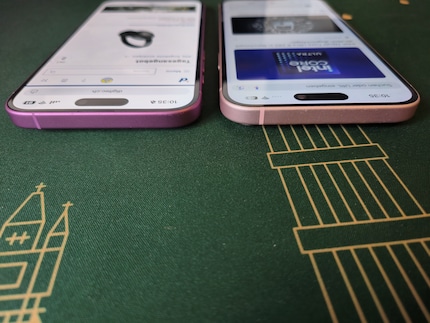
Source: Florian Bodoky
Apple’s again launching its new phones in new colours. This year’s phone’s available in ultramarine (a shade of blue bordering on purple), as well as teal, pink, white and black.
The exterior: the buttons make all the difference
Camera Control, which was touted as a major innovation, has been the subject of much ridicule. Rightly so? Or does the button, which Apple doesn’t call a button, offer more than expected? There’s another new addition in the basic models – the action button. Not new as such, but new to the basic models. It replaces the mute switch, which was already removed from the Pro models in the iPhone 15 version. By Apple’s standards, you’re given a lot of freedom here. You can assign virtually any function to the action button. You can make it start Shazam, record a voice memo, light the flashlight, silence the iPhone or simply start any app.
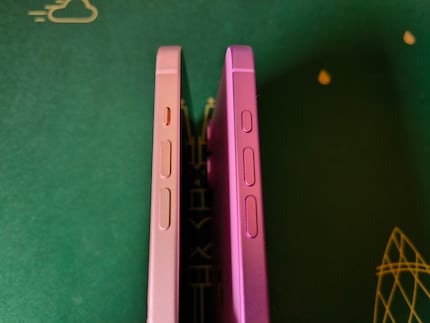
Source: Florian Bodoky
While this sounds good in theory, using the new button leaves me feeling ambivalent. I liked the mute switch, as it was a quick way to switch from silent to loud. This is also possible with the action button, but it’s so close to the volume button that I often accidentally (un)mute my phone when I actually want to turn the volume up.
Camera Control: a new button, yay!
Some grinned, others shook their head. What I find striking’s that Apple equipped the basic models with Camera Control, too. That’s definitely progress. Camera Control allows you to start the camera as well as control features such as zoom, saturation, colour depth and much more.
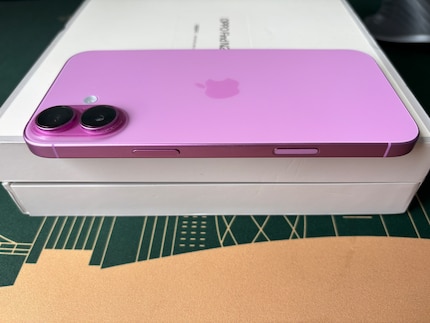
Source: Florian Bodoky
What exactly is Camera Control? It’s a capacitive surface that reacts to your finger. If you press it once, the camera starts. Press twice and it takes a photo. If you press and hold, it starts a video. And if you slide, you call up all the menus.
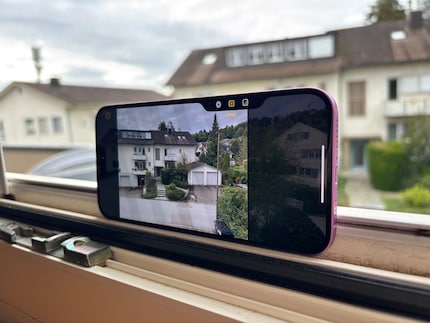
Source: Florian Bodoky
Apple has big hopes for this feature and is counting on me to cope with it. This is unusual for the manufacturer who usually takes me by the hand and guides me through every function.
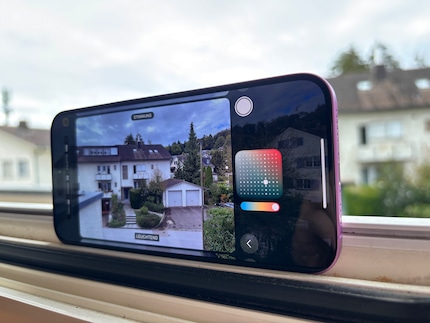
Source: Florian Bodoky
The button also holds a few secrets when it comes to image editing. You can set certain filters and edit the image even before you press the shutter button. If you’d like to read up about all the details of Camera Control, check out Samuel’s review of iPhone 16 Pro.
Camera: new ultra-wide sensor
Camera Control as well as its hardware and software features have a massive impact on the possibilities the cameras offers. But Apple’s also improved the camera itself in the basic model.
The main camera’s the same as last year. It features 48 MP and an f/1.6 sensor, which can take pictures with either 24 MP or 48 MP. Apple’s also equipped the phone with a 12 MP wide-angle camera with an f/2.2 aperture. What’s new is that I can take macro shots with it. Last year, this was still only possible with the Pro models. In addition, there’s 2× optical zoom featuring the same pixel binning technology that was already used last year. This delivers satisfactory results, although the basic model of iPhone 16 doesn’t have a telephoto camera. Check out how precisely the details are captured in this example taken at one metre from the tree – once without zoom, once with 2× zoom:
The new macro shots look good, too. And I like that I don’t have to adjust any settings. If I get within two centimetres of my subject, the phone automatically switches to wide-angle and macro mode, which I recognise by the small flower icon that lights up on the display. Here’s an example of a macro mode shot:

Source: Florian Bodoky
For images with high contrast, such as the dark foreground and the light background in the following photo, the system emphasises the former and reduces the exposure:

Source: Florian Bodoky
Whether you really need the Pro version, which offers better telephoto and image quality in poor lighting conditions, is up to you. It depends on what you do with your photos. If you send them via WhatsApp or post them on Instagram, their quality’s cropped anyway. In this case, I wouldn’t pay more to get the Pro model.
When it comes to videos, the performance remains largely the same, with the exception that iPhone 16 Plus now also supports spatial video and is Dolby Vision certified.
The chip: required for Apple Intelligence
The iPhone base models are usually equipped with the chips from last year’s Pro iPhone. As a result, you’d expect iPhone 16 to feature the A17 Pro chipset. But it doesn’t. Apple’s decided to equip this year’s phone with the latest A18 chipset. A light version of the A18 Pro, so to speak. It’s based on a new 3 nm manufacturing process and, according to the manufacturer, offers 30 per cent faster CPU performance than the previous A16 Bionic, which was featured in iPhone 15.
In Geekbench 6, iPhone 16 achieves single and multi-core scores of 3,265 and 7,894 respectively – a significant increase compared to iPhone 15’s scores of 2,520 and 6,110. What’s even more remarkable is that these scores are even better than those of the A17 Pro chip from iPhone 15 Pro Max, which are 2,899 in single-core and 7,204 in multi-core.
The GPU test shows a similar picture. Here, iPhone 16 has a score of 28,061, while iPhone 15 only scores 23,335. The Pro models from the previous year also lag behind.
This is noticeable when gaming. Although some games run stably on iPhone 15, performance on iPhone 16 is definitely better. In my performance test, iPhone 16 outperformed its predecessor. In a 1440p test run (Aztec Ruins, GFXBench Metal), the average FPS rate was 40.81, while the predecessor achieved 36.21 FPS (frames per second). In other words, despite the rather high demands, the frame rate remains constant and at an acceptable level.
I did notice one tiny flaw. The back of the device heats up during longer gaming sessions. It’s not unpleasant, but clearly noticeable. The scores – plus the extra RAM (8 GB instead of 6 GB) – are also largely responsible for Apple’s artificial intelligence working on the new phones. Even on the basic models.
Display: OLED, but still 60 Hertz
As already mentioned, the display diagonals of the two basic models haven’t changed. But they’ve been equipped with an OLED panel with a resolution of 2796 × 1290 pixels (460 dpi). The display looks good, boasts rich colours and an excellent contrast.
But I’m not happy with Apple’s decision to stick with 60 Hertz. Compared to the Pixel 9 Pro with a higher refresh rate, even a visual amateur like me notices that animations and action-packed scenes look smoother and more fluid on the Google device. However, if you’ve been using the basic iPhone models for a while, this’ll be less noticeable – unless you’re a real display or video connoisseur. I only noticed it in direct comparison.
The adaptive display brightness is also interesting. At least in theory, the 16-inch screen boasts a peak brightness of 2,000 nits. This means it’s equipped for any kind of sunlight. For more energy efficiency, however, screen brightness can now also be reduced to one nit.
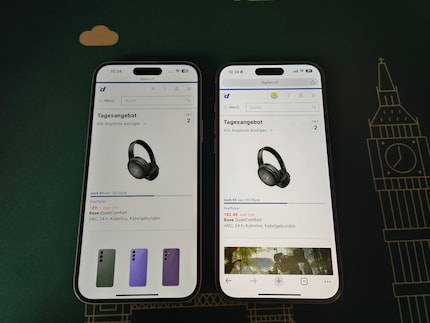
Source: Florian Bodoky
I find this very convenient when I want to use the phone in my dark bedroom at night without straining my eyes too much or waking up other people.
Battery: good progress, but no quantum leap
According to Apple, iPhone 16 Plus has a larger battery than the 15 series. As usual, the manufacturer doesn’t provide any details on capacity. From my experience, iPhone 16 offers enough capacity to cope with my daily use. Even after long days of using the phone a lot, I’m always left with at least 20 per cent battery.
The lack of information regarding milliampere hours and energy efficiency makes it difficult to make clear statements about how much the battery life’s really improved. Apparently, iPhone 16 Plus’s battery is 6.6. per cent better than iPhone 15 Plus’s. My benchmark test shows the iPhone 16 Plus battery lasts 10:24 hours in a continuous video loop (10:13 hours for iPhone 15 Plus) and 18:05 hours when browsing (15:21 hours for iPhone 15 Plus). Last but not least, when you’re gaming, iPhone 16 Plus shuts down after 11:22 hours, while iPhone 15 Plus lasts 10:37 hours. So the 6.6 per cent improvement seems accurate, even slightly too low.
In addition, iPhone 16 Plus now also charges via Qi2 with 25 watts. And even faster via cable, but Apple’s also keeping the details to themselves in this regard. If you’re charging with a cable, the phone takes 1h37 to get from 0 to 100%; wirelessly, it takes 2h01.
In a nutshell
How badly do you want Camera Control?
Apple’s improved iPhone in many (subtle) ways. The extent to which you notice the differences depends largely on how you use your smartphone. In general, the difference between the Pro and non-Pro model’s shrinking. Take the chip, for example.
If you have an iPhone 15 or 15 Plus, the performance won’t be enough for Apple Intelligence. You’d need the iPhone 16. But keep in mind, by the time all the functions are available in German, iPhone 17 will be around the corner.
That means upgrading from the iPhone 15 to 16’s currently only interesting if you’re really keen on the new wide angle and Camera Control. Otherwise, I don’t think it’s worth it. If you have an older device, however, you might want to upgrade to iPhone 16.
Pro
- Battery life’s more than enough
- Powerful CPU/GPU
- Camera/Camera Control allowing for creativity and variety
Contra
- 60 Hz display
- Annoying action button
- No Apple Intelligence yet

I've been tinkering with digital networks ever since I found out how to activate both telephone channels on the ISDN card for greater bandwidth. As for the analogue variety, I've been doing that since I learned to talk. Though Winterthur is my adoptive home city, my heart still bleeds red and blue.



